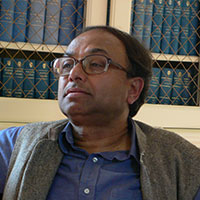The Ashok Kotwal Memorial Lecture was instituted in 2022, in memory of our founding Editor-in-Chief, as an annual lecture on key issues of development. For its second edition, I4I hosted Professor Pranab K. Bardhan on 30 November 2023 in New Delhi to speak on 'Inequality, Labour and Social Democracy’. A video recording of the lecture has been made available here.
Prof Bardhan talked about the fundamental inequalities in labour and capital distribution experienced by countries such as India and the US, and the role that decentralised labour organisations play in the treatment of labour as a disposable factor.
He began by introducing the issue of declining labour share, noting that the systematic weakening of labour organisations is a key institutional factor facilitating this. He discussed the role of trade unions, and the extent to which ‘strike-breaking’ and anti-union campaigns have contributed to their decline.
However, he emphasised that the missing scrutiny of active labour unions could hurt both labour and capital – he shared the case of worker unrest in Wistron's iPhone assembly factory near Bangalore, which employed a greater proportion of contract workers without benefits and extended workdays. He also brought up how many Indian states have statutorily allowed for 12-hour workdays and referred to Marx’s discussion in Capital, Vol.1 about the perils of this – that only myopic capitalists would support dilution of worker safety regulations.
He then touched upon the growth of informal labour, and the weakening of labour movements due to labour fragmentation. He pointed to the widening gulf between white- and blue-collar workers; gender-based fragmentation; the concentration of trade unions in the manufacturing sector, even as the economy moves towards services; and the incentive mismatch for self-employed individuals or farmers, whose income is tied to their land, to be involved in labour movements.
To overcome this fragmentation, he suggested five potential ‘universal’ demands which can be raised by unions to unite all workers – including universal access to community kitchens and childcare. He shared examples from European countries, where welfare benefits are administered through trade unions in the Ghent system; and the ‘active labour market policies’ of unions in Denmark which don’t focus on agitating against job loss but instead train workers for new ones. Citing the example of Costa Rica and Thailand, which have achieved universal health care, he argued that this is possible even in developing countries, and that despite their opposition, it will be an advantage for businesses, as free healthcare lowers the marginal cost of hiring workers.
He proposed universal basic income as a form of social democracy, and pondered the extent to which it could bridge the gap between formal and informal workers if it was a basic demand of trade unions. He went over some examples of such efforts, including those by Service Employees International Union (SEIU) in US and Canada, Unite in UK and Ireland, and the Self-Employed Women's Association (SEWA) in India, among others. He provided some back of the envelope calculations, which suggest that if just 10% of GDP were collected through effective taxation, it could be spent on health, education, and infrastructure, in addition to establishing a universal basic income programme. Moreover, he emphasised that trade unions have acted like anchors for shared identity and tamed sectarian passions. Their weakening has created a cultural void – which can be taken over by populist demagogues.
He then moved on to how financial globalisation weakened labour bargaining power: by creating an asymmetry between mobile capital and immobile labour, and the increasing capital concentration of the largest firms and business groups. He cited Acharya (2023) to explain that the top five business groups in India concentrated power largely through mergers and acquisition and not dynamism and innovation. This is reminiscent of Schumpeter’s elucidation of ‘muscular entrenchment’, he noted, an evolution away from his original theory of ‘creative destruction’. It also creates labour market monopsony, which is also exacerbated by geographical segmentation – he summarised some work on rural labour market fragmentation in India, and how schemes like MGNREGA are effective in weakening the monopsony power of landowners, as well as findings from the US and Peru which show that with employer concentration, labour only receives 57% of the value they create.
In this context, he went on to discuss how anti-monopoly or anti-trust policies can be a solution and should evolve away from focussing on consumer price as big tech companies can often charge nothing for use of their platforms but their concentration has other negative externalities. He pointed to the fallacy in the theory of ‘effective altruism’ – which advocates maximising profits and then diverting a proportion of that to social causes. However, labour and the environment – can be irreversibly damaged by this process. He advocated for substantial taxation of capital, and summarised some of the work being done on wealth and inheritance taxes in the US, UK and Europe. He also suggested that labour voice should be given a larger role in corporate governance; negotiation of trade and investment rules; and R&D decisions such as the introduction of AI – and highlighted how, in the past, unions played a role in the rollout of technology such as electricity. He shared some empirical evidence from Germany, where a large share of corporate governing boards are representative of workers, and Japan, where the ‘Toyota system of innovation’ made possible with collaboration between management and workers. Another danger to democratic determination of labour-friendly regulations can be solved by the public funding of elections – there are examples of some success of this in Scandinavian countries and Canada.
He concluded with the thought that social democracy, unlike democratic socialism, calls for the modification of capital in a labour-friendly direction with an aim to retain its dynamism rather than its replacement. This is borne out in WIPO data where Germany and Scandinavian social democracies rank fairly high on the Global Innovation Index. Businesses should do away with the attitude to squeeze labour and treat it as a disposable factor, which ultimately hurts both capital and labour. Even if economists have a tendency to imagine workers inhabiting a labour ‘market’, they are a social institution whose rights need not conflict with the interest of capital’s search for productivity and profits.
Further Reading
- Acharya, V (2023), ‘India at 75: Replete with Contradictions, Brimming with Opportunities, Saddled with Challenges’, Brookings Papers on Economic Activity.
- Amodio, F, P Medina and M Morlacco (2023), ‘Labor Market Power, Self-Employment, and Development’, STEG Working Paper WP016.
- Bardhan, P. (2022), A World of Insecurity: Democratic Disenchantment in Rich and Poor Countries, Harvard University Press.
- Bardhan, P. (1987), Land, Labor, and Rural Poverty: Essays in Development Economics, Columbia University Press.
- Hart, Oliver and Luigi Zingales (2017), “Companies Should Maximize Shareholder Welfare Not Market Value”, Journal of Law, Finance, and Accounting, 2: 247-274.
- Jäger, Simon, Benjamin Schoefer and Jörg Heining (2021), “Labor in the Boardroom”, The Quarterly Journal of Economics, 136(2): 669-725.
- Muralidharan, Karthik, Paul Niehaus and Sandip Sukhtankar (2023), “General Equilibrium Effects of (Improving) Public Employment Programs: Experimental Evidence From India”, Econometrica, 91(4): 1261-1295.
- Posner, Eric A., Suresh Naidu and Glen Weyl (2018), “Antitrust Remedies for Labor Market Power”, Harvard Law Review, 132(2).
- Rudra, Ashok and Pranab Bardhan (1985), “The Domain of Rural Labour Markets-Results of a Survey in West Bengal, 1981-82”, Economic & Political Weekly, 20(51-52).
- Solow, Robert M. (1990), The Labor Market at a Social Institution, Oxford: Basil Blackwell.
- Yeh, Chen, Claudia Macaluso and Brad Hershbein (2022), “Monopsony in the US Labor Market”, American Economic Review, 112(7): 2099-2138.




 20 December, 2023
20 December, 2023 





Comments will be held for moderation. Your contact information will not be made public.